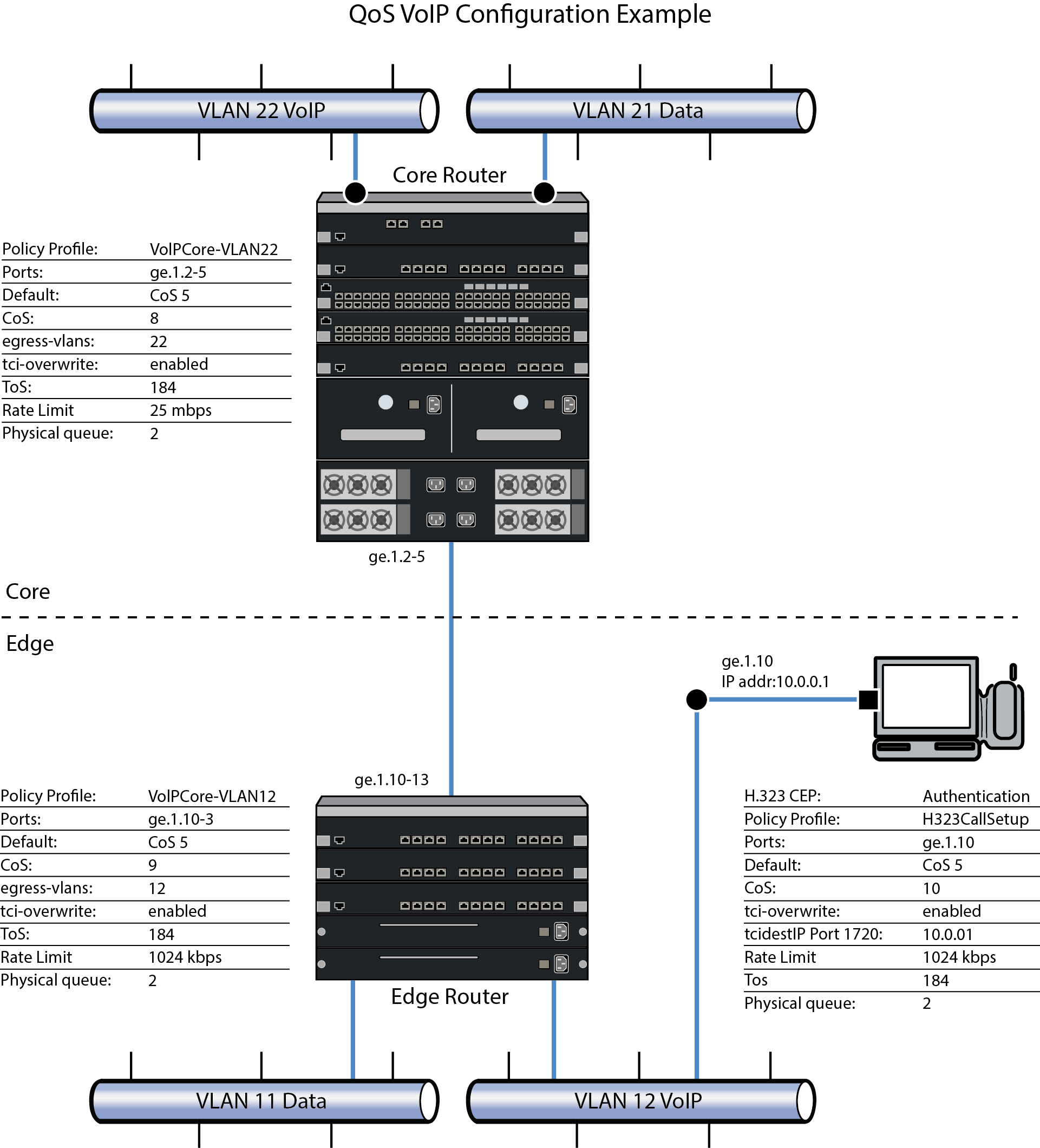In our example, an organization‘s network administrator needs to assure that VoIP traffic, both originating in and transiting the network of S- and K-Series edge switches and a S- and K-Series core router, is configured for QoS with appropriate priority, ToS, and queue treatment. We will also rate limit the VoIP traffic at the edge to 1024 Kbps to guard against DOS attacks, VoIP traffic into the core at 25 Mbps, and H.323 call setup at 5 pps. Data traffic retains the default configuration.
This example places QoS configuration within a policy context. Policy is not required to configure QoS.
This example assumes CEP authentication using H.323 for VoIP. If you are not authenticating your VoIP end point with CEP H.323 authentication, you will need to adjust the VoIP policy accordingly. For instance, SIP uses UDP port 5060, not the TCP port 1720.

Note
Extreme Networks highly recommends that you use the NetSight Policy Manager to configure QoS on your network, whether you are applying policy or not. This example discusses the QoS configuration using Policy Manager followed by CLI input summaries.To simplify this discussion of the configuration process, this example is limited to the VoIP configuration context. CoS Sample Values By Traffic Type provides a set of sample values for priority, IRL, and transmit queue across a number of real world traffic types. This table can be used as an aid in thinking about how you might want to apply CoS across your network. Note that scavenger class is traffic that should be treated as less than best effort: external web traffic, for instance.
CoS Sample Values By Traffic Type
| Name | Priority | IRL | Transmit Queue | ||||||
|---|---|---|---|---|---|---|---|---|---|
| Queue # | Shaping | WFQ | |||||||
| Edge | Core | Edge | Core | Edge | Core | Edge | Core | ||
| Loop Detect | 0 | 10 PPS | 10 PPS | 0 | 0 | 10% | 5% | 5% | |
| Scavenger | 0 | 15 Mbps | |||||||
| Best Effort | 1 | 1 | 1 | 80% | 45% | 45% | |||
| Bulk Data | 2 | ||||||||
| Critical Data | 3 | ||||||||
| Network Control | 4 | 40 PPS | 1 Mbps | 2 | 2 | 1Mbps | 25% | 25% | |
| Network Management | 5 | 2 Mbps | |||||||
| RTP | 6 | 1 Mbps | 25 Mbps | 3 | 3 | 25% | 25% | ||
| Voice/Video | 7 | ||||||||
QoS Configuration Example displays the network setup for this example configuration, with the desired Profile/QoS summary for each network node. Each node is configured with VoIP and Data VLANs. Each VoIP VLAN contains four 1-gigabit interfaces for each node.

A core profile for the router and an edge profile for the switch provide for the difference in rate limiting needs between the enduser and aggregation devices. A call setup profile provides rate limiting for the setup aspect of the VoIP call. Each edge and core VLAN profile will be configured for default CoS 5 (best default priority for voice and video), the addition of its associated VLAN to its egress VLAN list, and ToS overwrite. We will create a separate CoS for both the edge and core to handle ToS, rate-limit and queue configuration for these devices.
The H.323 call setup profile will be configured so that TCP call setup traffic on the TCP destination port 1720:10.0.0.1 of its gigabit link will be configured for the proper rate limit on that port.
Using NetSight Policy Manager, configure the policy roles and related services as follows:

 Print
this page
Print
this page Email this topic
Email this topic Feedback
Feedback